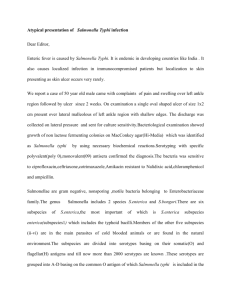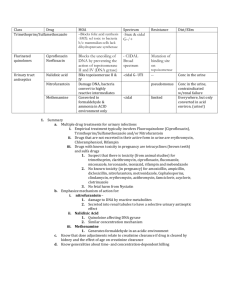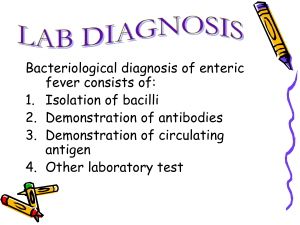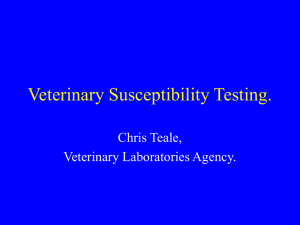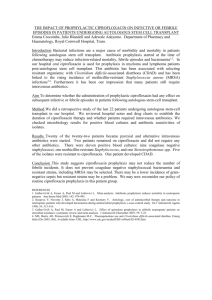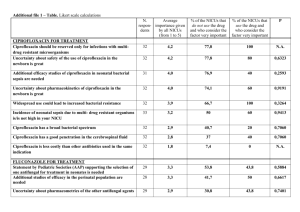Dr. KK Patel
advertisement
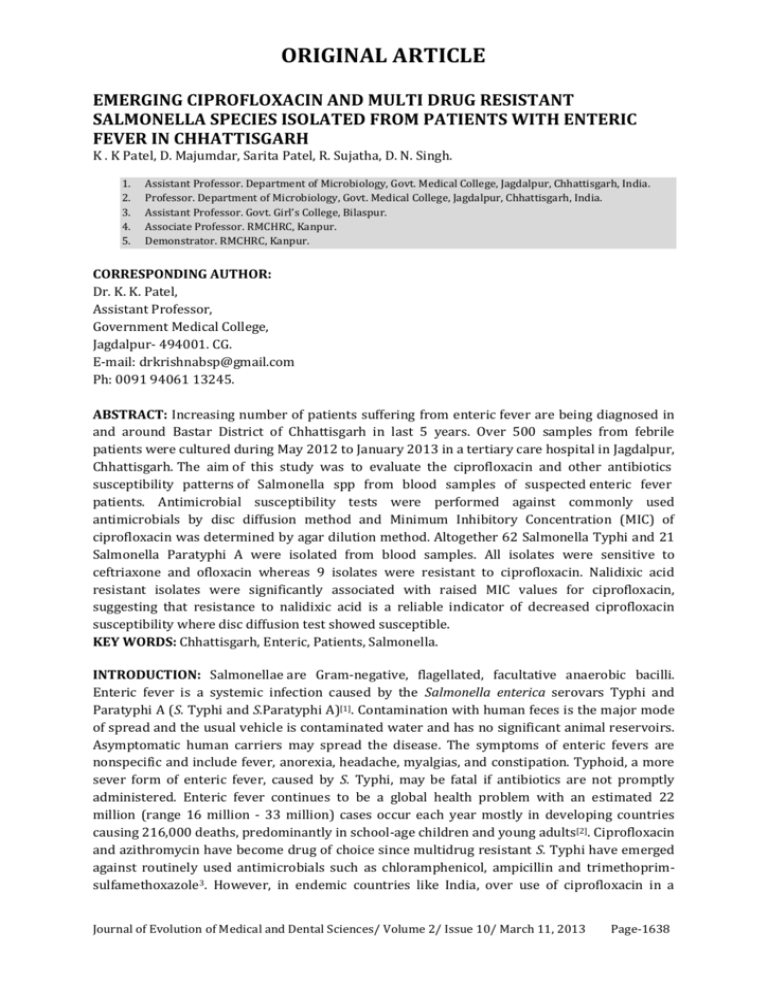
ORIGINAL ARTICLE EMERGING CIPROFLOXACIN AND MULTI DRUG RESISTANT SALMONELLA SPECIES ISOLATED FROM PATIENTS WITH ENTERIC FEVER IN CHHATTISGARH K . K Patel, D. Majumdar, Sarita Patel, R. Sujatha, D. N. Singh. 1. 2. 3. 4. 5. Assistant Professor. Department of Microbiology, Govt. Medical College, Jagdalpur, Chhattisgarh, India. Professor. Department of Microbiology, Govt. Medical College, Jagdalpur, Chhattisgarh, India. Assistant Professor. Govt. Girl’s College, Bilaspur. Associate Professor. RMCHRC, Kanpur. Demonstrator. RMCHRC, Kanpur. CORRESPONDING AUTHOR: Dr. K. K. Patel, Assistant Professor, Government Medical College, Jagdalpur- 494001. CG. E-mail: drkrishnabsp@gmail.com Ph: 0091 94061 13245. ABSTRACT: Increasing number of patients suffering from enteric fever are being diagnosed in and around Bastar District of Chhattisgarh in last 5 years. Over 500 samples from febrile patients were cultured during May 2012 to January 2013 in a tertiary care hospital in Jagdalpur, Chhattisgarh. The aim of this study was to evaluate the ciprofloxacin and other antibiotics susceptibility patterns of Salmonella spp from blood samples of suspected enteric fever patients. Antimicrobial susceptibility tests were performed against commonly used antimicrobials by disc diffusion method and Minimum Inhibitory Concentration (MIC) of ciprofloxacin was determined by agar dilution method. Altogether 62 Salmonella Typhi and 21 Salmonella Paratyphi A were isolated from blood samples. All isolates were sensitive to ceftriaxone and ofloxacin whereas 9 isolates were resistant to ciprofloxacin. Nalidixic acid resistant isolates were significantly associated with raised MIC values for ciprofloxacin, suggesting that resistance to nalidixic acid is a reliable indicator of decreased ciprofloxacin susceptibility where disc diffusion test showed susceptible. KEY WORDS: Chhattisgarh, Enteric, Patients, Salmonella. INTRODUCTION: Salmonellae are Gram-negative, flagellated, facultative anaerobic bacilli. Enteric fever is a systemic infection caused by the Salmonella enterica serovars Typhi and Paratyphi A (S. Typhi and S.Paratyphi A)[1]. Contamination with human feces is the major mode of spread and the usual vehicle is contaminated water and has no significant animal reservoirs. Asymptomatic human carriers may spread the disease. The symptoms of enteric fevers are nonspecific and include fever, anorexia, headache, myalgias, and constipation. Typhoid, a more sever form of enteric fever, caused by S. Typhi, may be fatal if antibiotics are not promptly administered. Enteric fever continues to be a global health problem with an estimated 22 million (range 16 million - 33 million) cases occur each year mostly in developing countries causing 216,000 deaths, predominantly in school-age children and young adults[2]. Ciprofloxacin and azithromycin have become drug of choice since multidrug resistant S. Typhi have emerged against routinely used antimicrobials such as chloramphenicol, ampicillin and trimethoprimsulfamethoxazole3. However, in endemic countries like India, over use of ciprofloxacin in a Journal of Evolution of Medical and Dental Sciences/ Volume 2/ Issue 10/ March 11, 2013 Page-1638 ORIGINAL ARTICLE population where nalidixic acid resistant S. Typhi (NARST) strains are prevalent has led to a subsequent increase in the occurrence of S.Typhi isolates resistant to this ciprofloxacin4,5. An increase in minimum inhibitory concentration (MIC) ciprofloxacin in strains of S, Typhi have been reported Globally 4,6,7. There have been report of therapeutic failure of ciprofloxacin too 5,8. Reduced susceptibility to fluoroquinolones is not detected by disc diffusion tests easily which has led to discussion regarding whether the current fluoroquinolones breakpoint criteria used for Salmonella spp. remain appropriate. An increased in number of patients with enteric fever admitted in the Maharani Hospital, Jagdalpur, Chhattisgarh, over the last few years has been recorded. Since ciprofloxacin is the first line of antimicrobial, clinicians should be aware of the possibility of the treatment failures of infections with S. Typhi and S. Paratyphi A strains since reduced susceptibility to ciprofloxacin is not detected by routine susceptibility tests. To monitor the increases in the MIC of fluoroquinolones in S. Typhi and emerging strains of S. Paratyphi A the present study was undertaken. We also investigated the relevance of using nalidixic acid resistance as a surrogate marker of reduced fluoroquinolone susceptibility. MATERIALS AND METHODS: The study was carried out prospectively at the Department of Microbiology, Government Medical College & Teaching Hospital, Jagdalpur Chhattisgarh from May 2012 to January 2013. Ethical clearance was taken from institutional review board. A total of 500 blood samples of suspected enteric fever patients were included. Ten milliliter of venous blood from two different sites were collected by aseptic manner and incubated in pair in a BD Bactec 9050 system. Positive samples were subcultured on sheep blood agar and deoxycholate citrate agar for growth. Representative colonies from pure growth were subjected to standard biochemical tests and serotyping was performed by slide agglutination test using specific antisera (CRI, Kasauli). Antibiotic susceptibility of the isolates was determined using Kirby‐Bauer disc diffusion method10 on Mueller Hinton Agar at pH 7.2. Antibiotic discs tested were ampicillin (AM10), nalidixic acid (NA30), ofloxacin (OFX5), ciprofloxacin (CIP5), ceftriaxone (CRO30), cotrimoxazole (SXT) and chloramphenicol (C30) (BD BBL Sensi-Disc Antimicrobial Susceptibility Discs). Minimum inhibitory concentration (MIC) of ciprofloxacin for Salmonella spp. isolates was determined by an agar dilution method as per CLSI guidelines. 10 Seven different concentrations (32, 16, 8, 4, 2, 1, 0.5 μg/ml) of ciprofloxacin (Sigma Aldrich 17850-5G-F) solution were prepared in Mueller-Hinton broth (Sigma Aldrich 70192-500G) for MIC determination. The lowest concentration of the drug that gave no growth was recorded as the MIC of the test isolate. Salmonella typhi ATCC 700931 was used as control strain. MIC (µg/mL) ≤1 2 ≥4 Interpretation Susceptible Intermediate Resistant RESULTS: Out of 500 blood samples, 83 (16.6%) yielded Salmonella spp. of which, 62 (74.7%) isolates were S. Typhi and 21 (25.3%) isolates were S. Paratyphi A. The age of patients under the investigation ranged from 3 years to 70 years (mean 24.1±14.16). The age group 11‐40 years accounted for maximum (74.7%) enteric fever cases [Table 1]. There were 37 females and 46 male patients. All the isolates were sensitive to azithromycin and ofloxacin. Seven isolates of S. Typhi and 2 of S. Paratyphi A were resistant to ciprofloxacin. Seventeen S. Typhi were sensitive to all the antimicrobials tested. Nineteen of S. Typhi and 10 of S. Paratyphi were resistant to a Journal of Evolution of Medical and Dental Sciences/ Volume 2/ Issue 10/ March 11, 2013 Page-1639 ORIGINAL ARTICLE single antimicrobial (ampicillin/trimethoprim-sulphomethoxazole/chloramphenicool/nalidix acid/ceftriaxone). Twenty six (41.9%) of S. Typhi and 11 (52.4%) of S. Paratyphi were resistant to 2 or more antimicrobials [Table 2]. The highest MIC value of ciprofloxacin among the isolates was 8μg/ml and the lowest was 0.5μg/ml. Out of the 62 isolates of Typhi, 7 (11.3%) isolates were resistant (MIC ≥4 µg/ml) and 7 showed reduced susceptibility to ciprofloxacin (MIC 2 µg/ml). Out of the 21 isolates of S. Paratyphi A, 2 (8.7%) isolates were resistant to ciprofloxacin. All the isolates having ciprofloxacin MIC ≥1μg/ml were resistant to nalidixic acid by disc diffusion whereas isolates having MIC ≤1μg/ml showed variable results. The difference in mean ciprofloxacin MIC in nalidixic acid resistant Typhi and Paratyphi A was statistically significant (p<0.001). Two isolates of Typhi which were susceptible to ciprofloxacin in the disc diffusion test showed reduced susceptibility to ciprofloxacin in the MIC test (MIC 2 µg/ml). DISCUSSION: Rate of isolation of Salmonellae from blood culture was 16.6%, which was higher compared to earlier rate of isolation (laboratory records of Department of Microbiology, Govt. Medical College, Jagdalpur, Chhattisgarh). This may be due to improved culture method using Bectec 9050, which also includes supply of blood culture medium by the manufacturer. These media contains antimicrobial absorbing resins and therefore yields growth of bacteria even if the patient had received antimicrobial treatment prior to sampling. Most patients are administered antimicrobials before they are brought to the hospital. Moreover blood samples were cultured in pairs, enhancing increased probability of positive growth. Five samples yielded mixed growth or growth of commensals and hence rejected as contamination. The blood culture positive rate was the highest (74.7%) in the age group 10‐40 years. Patients of this age group are most active and exposed to sources of infection such as roadside vendors and stalls. As Jagdalpur, Bastar, Chhattisgarh, receives very high rainfall during the monsoon, there are flood like conditions around the city which may contribute to higher incidence of enteric fever cases during this season. More S. Typhi were isolated than S. Paratyphi A in the present study (74.7% (n=62) and 25.3% (n=21, respectively). Isolates of both showed resistance to ampicillin, chloramphenicol, cotrimoxazole and nalidixic acid (MDR). The current frequency of MDR S. Typhi (42%) and S. Paratyphi (52.4%) isolates suggests that these antibiotics for the treatment of enteric fever may be avoided. Earlier reports from various parts of India and Bangladesh show that incidence of MDR S. Typhi isolates is high and widespread. 9, 10, 11 All MDR isolates and isolates with resistance to ciprofloxacin were susceptible to azithromycin and ofloxacin. Ceftriaxone remains the first line drug against infections with ciprofloxacin resistant S. Typhi as only 3 (4.8%) S. Typhi isolates were found to be resistant to ceftriaxone. In the present study, rate of nalidixic acid resistance, was high. S. Paratyphi A isolates showed higher rate (100%) of nalidixic acid resistance than S. Typhi (22.3%). Nalidixic acid resistance is a marker of emerging ciprofloxacin resistance. In our study, ciprofloxacin resistant S. Typhi and S. Paratyphi A were not high (11.3 and 9.5% respectively) by disc diffusion method. In our study it was observed that the minimum MIC value of ciprofloxacin was 0.5μg/ml and the maximum MIC value was 16μg/ml. For ciprofloxacin there has been an increase in minimum inhibitory concentration in strains in India4, as well as in Bangladesh12. Salmonella isolates having MIC ≥ 1μg/ml of ciprofloxacin were nalidixic acid resistant whereas isolates having MIC ≤1 μg/ml were resistant or susceptible to nalidixic acid. This revealed that screening for nalidixic acid resistance led to the detection of all isolates with MIC of ciprofloxacin ≥ 1μg/ml. However, performing MIC for every isolate in a routine Microbiology laboratory is a time consuming and labor intensive Journal of Evolution of Medical and Dental Sciences/ Volume 2/ Issue 10/ March 11, 2013 Page-1640 ORIGINAL ARTICLE process. Hence screening with nalidixic acid disc is advocated to detect the intermediately susceptible strains of S. Typhi and prevent ciprofloxacin treatment failure. CONCLUSIONS: Reduced susceptibility to ciprofloxacin may not be detected by disc diffusion method and therefore should not be prescribed unless isolates are susceptible to nalidixic acid as well. Prescribing ampicillin, trimethoprim-sulphomethoxazole or chloramphenicol for enteric fever may lead to treatment failure in Chhattisgarh area. Ceftriaxone should be the first-line antimicrobial for empirical treatment of enteric fever and ofloxacin and azithromycin should be kept in reserve. There should be a screening program of food vendors and food handlers of Jagdalpur to detect carrier states of S. Typhi as a preventive measure. REFERENCES: 1. Chandey M, Multani AS. A comparative study of efficacy and safety of azithromycin and ofloxacin in uncomplicated typhoid Fever: a randomised, open labelled study. J Clin Diagn Res. 2012 Dec;6(10):1736-9. 2. Crump JA, Luby SP, Mintz ED. The global burden of typhoid fever. Bull World Health Organ 2004;82:346-53. 3. Butt T, Ahmad RN, Mahmood A, Zaidi S. Ciprofloxacin treatment failure in typhoid fever case, Pakistan. Emerg Infect Dis. 2003; 9: 1621-1622. 4. Harish BN, Madhulika U, Parija SC. Current pattern in antimicrobial susceptibility of Salmonella Typhi isolates in Pondicherry. Indian J Med Res. 2004; 120: 111-114. 5. Harish BN, Menezes GA, Sarangapani K, Parija SC. A case report and review of the literature: Ciprofloxacin resistant Salmonella enterica serovar Typhi in India. J Infect Dev Ctries. 2008; 2: 324-327. 6. Threlfall EJ, Ward LR. Decreased susceptibility to ciprofloxacin in Salmonella enterica serotype Typhi, United Kingdom. Emerg Infect Dis. 2001; 7: 48-450. 7. Asna SM, Haq JA, Rahman, M. Nalidixic acid-resistant Salmonella enterica serovar typhi with decreased susceptibility to ciprofloxacin caused treatment failure: a report from Bangladesh. Jpn J Infect Dis. 2003; 56:32-33. 8. Gay K, Robicsek A, Strahilevitz J, Park CH, Jacoby G, Barrett TJ, Medalla F, Chiller TM, Hooper DC. Plasmid-mediated quinolone resistance in non-Typhi serotypes of Salmonella enterica. Clin Infect Dis. 2006; 43: 297-304. 9. Sanghavi SK, Mane MP, Niphadkar KB. Multidrug resistance in Salmonella serotypes. Indian J Med Microbiol. 1999; 17: 88-90. 10. Chande C, Shrikhande S, Kapale S, Agrawal S, Fule RP. Change in antimicrobial resistance pattern of Salmonella Typhi in central India. Indian J Med Res. 2002; 115: 248-250. 11. Rahman M, Ahmad A, Shoma S. Decline in epidemic of multidrug resistant Salmonella Typhi is not associated with increased incidence of antibioticsusceptible strain in Bangladesh. Epidemiol Infect. 2002; 129: 29-34. 12. Asna SM, Haq JA, Rahman, M. Nalidixic acid-resistant Salmonella enterica serovar typhi with decreased susceptibility to ciprofloxacin caused treatment failure: a report from Bangladesh. Jpn J Infect Dis. 2003; 56: 32-33. Journal of Evolution of Medical and Dental Sciences/ Volume 2/ Issue 10/ March 11, 2013 Page-1641 ORIGINAL ARTICLE Table 1. Age and sex distribution of blood culture confirmed Enteric fever cases. Age Group Male Female Both sexes 1-10 11-20 21-30 31-40 41-50 51-60 61-70 5 19 6 7 5 3 1 4 13 10 7 2 1 9 32 16 14 7 3 2 Table 2. Antimicrobial susceptibility pattern of S. Typhi and S. Paratyphi A S.N. Antimicrobial S. Typhi (n=62) S. Paratyphi A (n= 21) 1 2 3 4 5 Sensitive to all antimicrobials tested Resistant to one antimicrobial Resistant to 2 or more antimicrobials Ciprofloxacin resistant Nalidixic acid resistant 17 (27.4% ) - 19 (30.6%) 10 (47.6%) 26 (41.9%) 11 (52.4%) 7 (11.3%) 14 (22.3%) 2 (9.5%) 21 (100%) Journal of Evolution of Medical and Dental Sciences/ Volume 2/ Issue 10/ March 11, 2013 Page-1642


